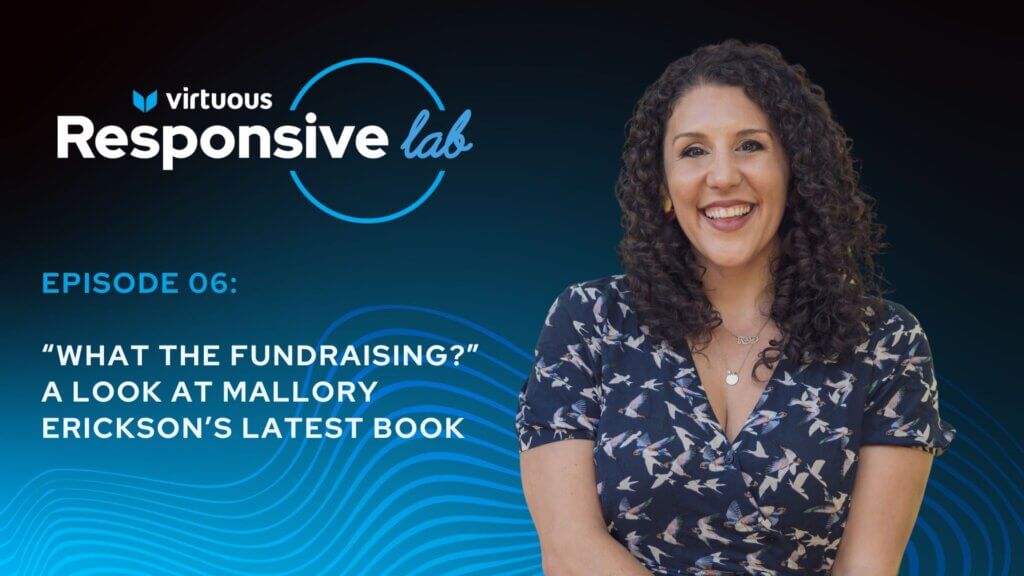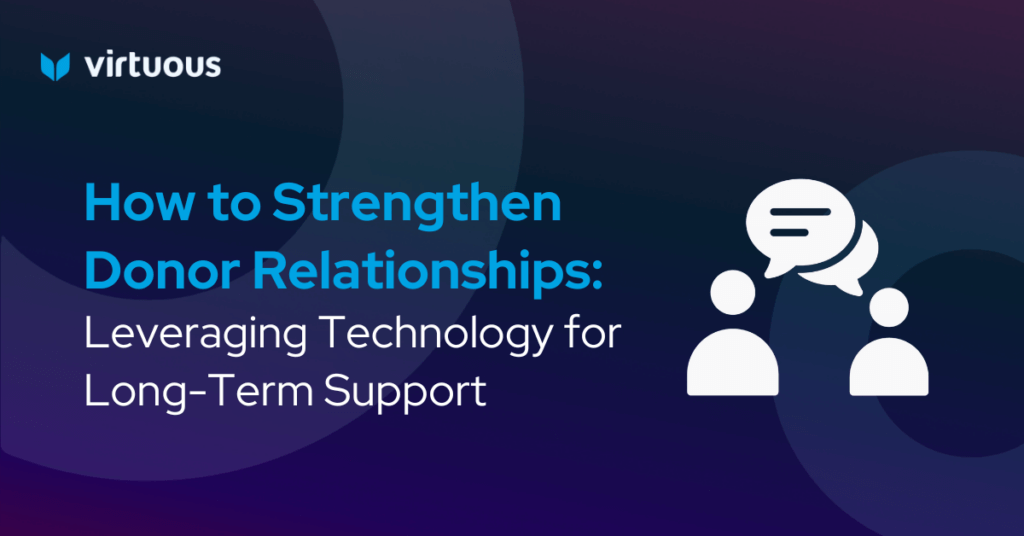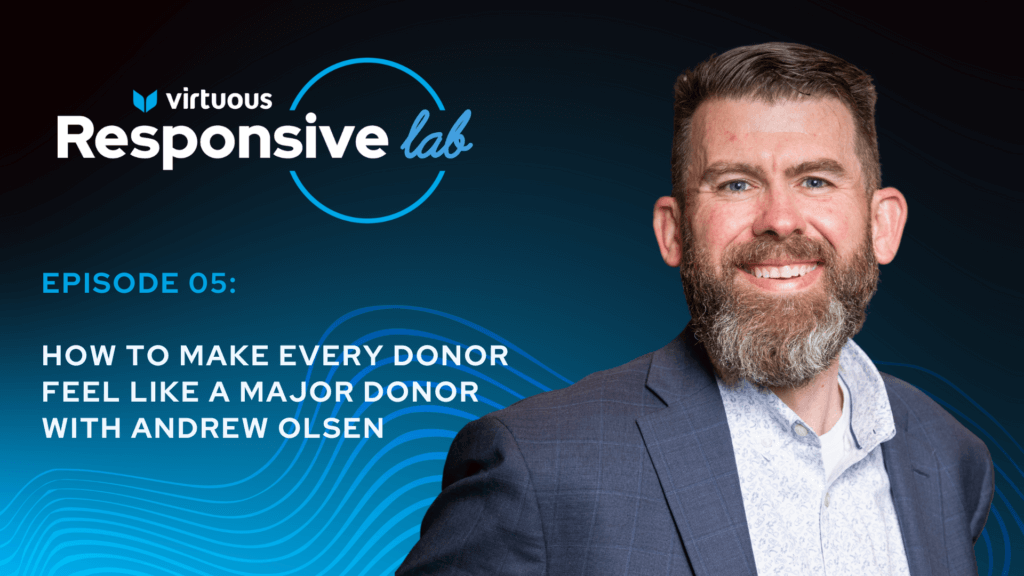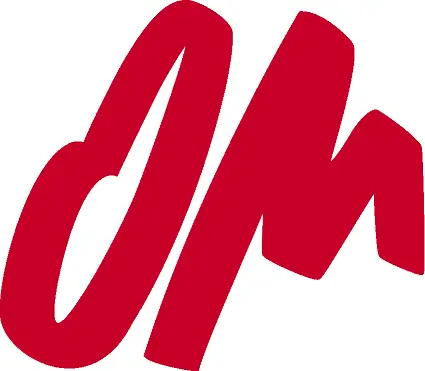In a world where personalization is the new currency—where your favorite coffee shop remembers your order and your playlist understands your mood—nonprofits should be leading the charge. After all, they’re in the business of human connection. But here’s the twist: They’re falling behind, and donor retention is the glaring symptom. It’s not merely a leaky bucket—it’s a floodgate that’s been left wide open.
Enter Responsive Fundraising: A seismic shift that’s not just about sealing that floodgate, but turning the tide altogether. It’s a recognition that cultivating generosity isn’t just about asking for more—it’s about forging deeper, more personal connections with donors.
But therein lies the crux of the problem: While giving is intrinsically personal, the technology and processes that most nonprofits rely on are anything but.
The modern donor lives in a world of hyper-personalized experiences—think Netflix, Amazon, DoorDash. They’re not just customers—they’re participants in a tailored narrative. So why should their experience with your cause be any different?
According to the Fundraising Effectiveness Project, a staggering 81.4% of first-time donors never make a second gift. To put it another way, if you gain 100 new donors today, only 19 are likely to contribute again. But here’s the silver lining: organizations that adopt Responsive Fundraising strategies typically see a 12% increase in donor retention.

So, let’s dive in. Let’s explore how you can not only stop the leak but fill your bucket to the brim—all while creating meaningful, lasting relationships with your donors.
What is Donor Retention?
Donor retention isn’t a numbers game—it’s a relationship game. It’s not about how many donors you can get—it’s about how many you can keep engaged, invested, and ready to take another step on the journey with you.
Donor retention is more than just a statistic—it’s the backbone of your nonprofit’s long-term success. It quantifies how well you’re converting first-time donors into ongoing supporters. But beyond the numbers, it’s about forging lasting relationships.
Each donation isn’t just a transaction—it’s a chapter in a continuing story between your organization and the donor. When donors consistently support your cause, they’re doing more than just contributing financially. They’re becoming part of your community, amplifying your mission, and transforming a one-time act of charity into a sustained movement for change.
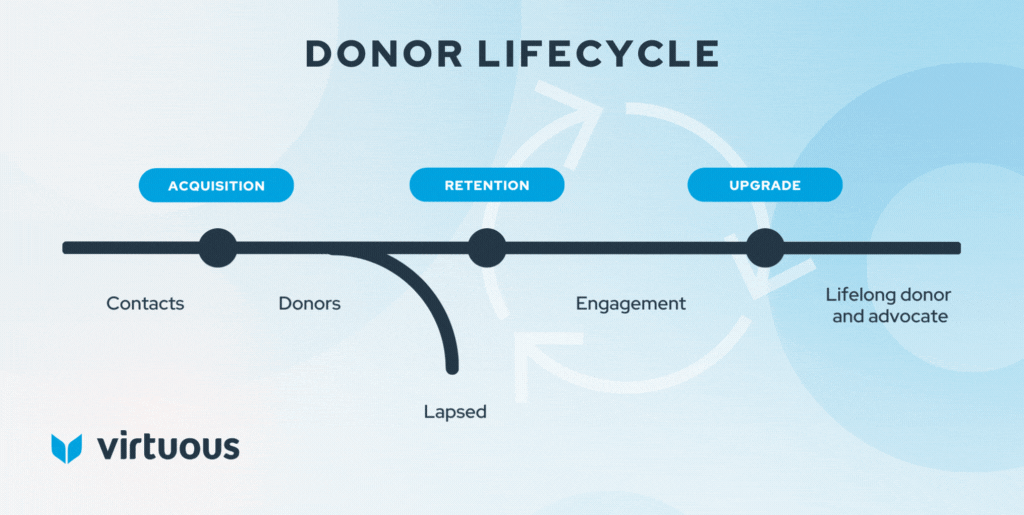
Why is this so important? Because the cost of acquiring a new donor often far exceeds the cost of retaining an existing one. According to various studies, it can cost up to five times more to attract a new donor than to keep an existing one. Moreover, the lifetime value of a retained donor can be exponentially greater, as they are more likely to engage in multiple forms of support—be it volunteering, advocacy, or planned giving.
In a nutshell, focusing on donor retention isn’t just good ethics—it’s good economics. It’s an investment in the long-term viability and impact of your organization.
The Donor Retention Crisis
Donor retention isn’t just a metric—it’s a relationship in numbers. It’s the art of turning a single act of generosity into a lifelong conversation.
We’re in the midst of a generosity crisis, and it’s not because people have stopped caring. It’s because the systems we’ve built to facilitate that caring are fundamentally flawed. The Fundraising Effectiveness Project reports that the average donor retention rate across the sector is a mere 45%. That’s less than half. Imagine if half of your loyal customers walked out of your store and never returned. It’s unsustainable.
But it’s not just about numbers—it’s about the stories those numbers tell. With 81.4% of first-time donors never making a second gift, that’s not just a statistic—it’s a narrative of missed opportunities and broken connections.
So, what’s going wrong? Why is the sector that’s built on human connection failing so miserably at maintaining those connections? The answer lies not just in what we’re doing but in how we’re doing it. And that’s what we’re here to explore.
The Financial Cost of Donor Attrition
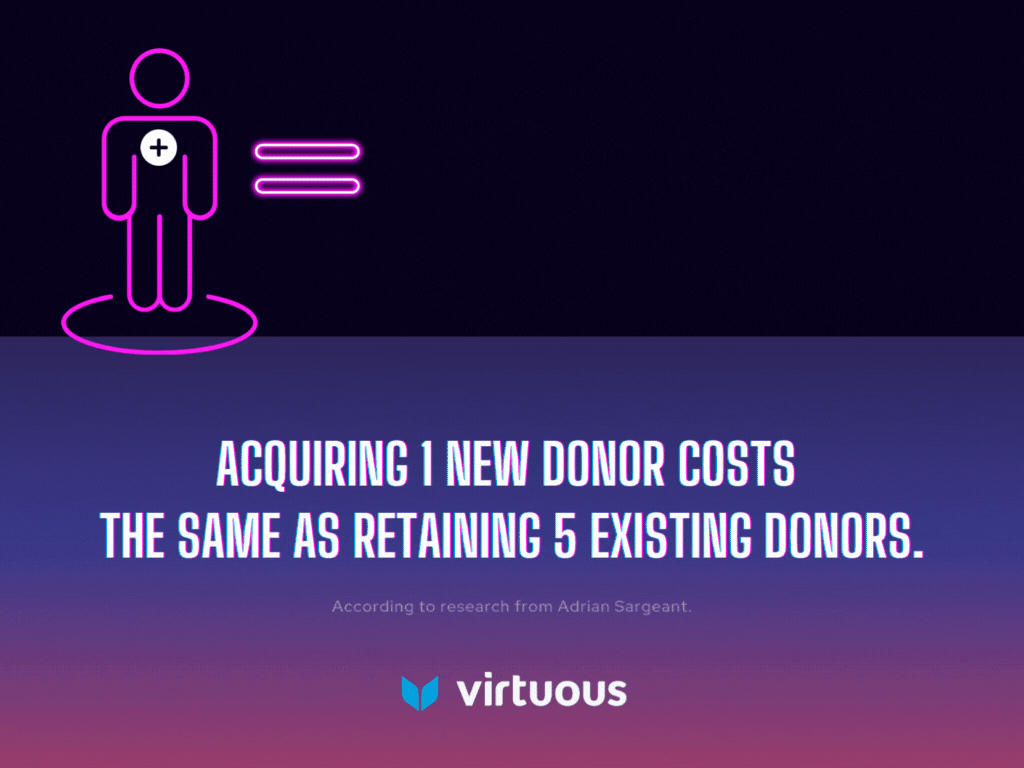
When a donor walks away, the financial impact is immediate, but the ripple effects are far-reaching. While it’s commonly known that acquiring a new donor can be five times more expensive than retaining an existing one, the cost isn’t just monetary.
When a donor leaves, they take with them not just their financial support but also their trust, their network, and their advocacy for your cause. Donor attrition has a domino effect that impacts not just revenue but also future engagement and referrals.
Moreover, each lost donor is a lost data point, a missed opportunity to refine your strategies and deepen your understanding of what makes your donors tick.
The cost of donor attrition is multi-dimensional. It’s not just a line item on a budget—it’s a complex web of lost opportunities and diminished capacities.
The Relational Cost of Donor Attrition
The cost of losing donors isn’t just a line item on a budget—it’s a ripple effect that disrupts your entire mission. When you’re too busy chasing the next dollar to notice the ones slipping through your fingers, you’re not just setting up a budget—you’re setting up a treadmill. And this treadmill keeps your fundraising team running in place, never actually gaining ground.
This cycle of stagnation extends beyond dollars and cents. Staff turnover isn’t just a farewell party and an empty desk—it’s a loss of institutional memory and donor relationships. Each new hire starts from scratch, learning your mission and your donors—all while the clock keeps ticking and the treadmill keeps running.
The Path Forward
When donor retention is high, your mission thrives and your community benefits. This crisis isn’t a dead end, but a pivotal moment—a chance to redefine how you engage with your supporters. And the key to unlocking higher retention rates lies in forging personal connections with your donors. That’s where Responsive Fundraising comes into play, serving as the catalyst that enables nonprofits to build these meaningful relationships at scale.
Responsive Fundraising and Donor Retention
Responsive Fundraising isn’t just a tactic—it’s a philosophy. It’s the art of listening so intently to your donors that your next move becomes their obvious choice, turning the act of giving into a collaborative masterpiece.
Let’s acknowledge something important: Nonprofits aren’t the bad guys here. Far from it. They’re often doing the best they can with the tools they have, but the limitations are real—either you need a massive team for manual customization or technology that allows for personalization at scale. The ‘one-size-fits-all’ communication tactics aren’t malicious—they’re just outdated and misaligned with what today’s donors expect.
Donors are a diverse group, each with unique motivations and ways they connect with your mission. They’re not just names on a list—they’re individuals seeking meaningful engagement. The high attrition rates aren’t a sign of fickle donors but of a system that fails to meet their needs for a more personalized relationship.
The solution? Responsive Fundraising. It’s not just a buzzword—it’s a shift from transactional to relational engagement. It enables personalization at scale, turning ‘one-to-many’ communications into ‘one-to-one’ dialogues that make donors feel seen, heard, and valued.
Interestingly, nonprofits have long provided this level of personalization to major donors. The challenge now is to extend that same level of care to every supporter.
The Personalization Gap: Major Donors vs. Everyday Supporters
Historically, cultivating personal connections has been a privilege extended mainly to major donors, while everyday donors often find themselves receiving the same general email or appeal letter month after month. This imbalance is a significant contributor to the staggering 55% attrition rate that plagues most nonprofits year after year.
But don’t just take it from us, according to research from Adrian Sargeant, two of the primary reasons why donors choose not to give again are:
- Inappropriate asks and impersonal messages
- A lack of acknowledgment and transparency
So, how do we bridge this gap? How do we extend the personalized touch that major donors receive to every supporter without overwhelming our resources? Enter the transformative role of automation in donor retention.
The Role of Automation in Donor Retention
Automation is often misunderstood in the nonprofit sector. Far from being a cold, impersonal machine, it’s actually the catalyst that enables you to deepen your relationships with donors. At its core, automation is about efficiency and consistency—two elements crucial for donor retention. It’s not about removing the human touch—it’s about enhancing it, allowing you to create hyper-personalized experiences at scale.
By harnessing the power of automation, Responsive Fundraising enables organizations to create multichannel, personalized experiences at scale—turning every interaction into an opportunity for meaningful connection. This isn’t just about inserting a donor’s name into an email—it’s about tailoring your communications to reflect their unique interests, history, and preferences.
The impact of this approach is quantifiable. Automated, personalized emails have a 26% higher open rate—not because of clever subject lines, but because they resonate with the individual. And the engagement doesn’t stop at opening an email—donors are 71% more engaged when they feel seen and heard. In a world where personalization is the expectation, Responsive Fundraising provides the approach to meet and exceed that standard.
“[Donors will] reply to these emails that are automated, and I’m like I didn’t e-mail them and it takes a second for me to realize this is one of the automated emails. But these supporters are talking to me like they know me because the automated email felt so natural for them.”
Samantha Mellon, Director of Development at A Kid’s Place Tampa Bay
Implementing Responsive Fundraising for Better Retention
After understanding the role that automation plays in donor retention, it’s clear that technology is an enabler—not a replacement—for genuine relationships. But before diving into the tech solutions, let’s focus on some practical responsive strategies that can make a significant difference in your donor retention rates. These strategies are not just about using the right tools—they’re about adopting the right mindset and practices that can be implemented even without advanced technology.
1. Active Listening: Beyond Social Media
Practical Tip: You don’t need a fancy tool to listen. Start by paying close attention to donor interactions—be it emails, social media comments, or feedback forms.
Why it Matters: Active listening gives you valuable insights into what your donors care about, allowing you to tailor your communications and appeals more effectively.
2. Consistent Communication: More than Just Emails
Practical Tip: Use a calendar to schedule regular check-ins with your donors. This could be a monthly newsletter, quarterly updates, or even a yearly ‘impact report.’
Why it Matters: Consistency in communication keeps your donors engaged and makes them feel like part of your mission, not just a wallet.
3. Personalized Engagement: Not Just Financial Asks
Practical Tip: When communicating, don’t always ask for money. Invite donors to webinars, share volunteer opportunities, or simply update them on what their last donation achieved.
Why it Matters: Offering varied engagement opportunities shows that you value your donors for more than just their financial contributions.
4. Data-Driven Reflection: No Fancy Tools Required
Practical Tip: You don’t need specialized software to start being data-driven. Begin by setting aside time each month to review key metrics like donor engagement levels, frequency of donations, and the success of your recent campaigns.
Why it Matters: Taking the time to analyze these metrics helps you understand your donors better and fine-tune your strategies, setting the stage for more effective engagement in the future.
Adopting these practical strategies empowers you to build stronger, more meaningful relationships with your donors immediately. Yet, as your donor base expands, technology shifts from being a luxury to a necessity, enabling you to maintain these personalized relationships at scale.
Getting Started with Automation for Donor Retention
If you’re ready to take the next step in donor retention, automation is your ally. It amplifies your efforts, allowing you to maintain that personal touch while reaching more donors than you ever could manually.
Here are some practical ways to integrate automation into your donor retention strategies.
- Automated Welcome Series: The moment someone makes their first donation is the perfect time to start building a relationship. An automated welcome email series can introduce new donors to your mission, share success stories, and guide them on how to get more involved.
- Milestone Acknowledgments: Use automation to recognize and celebrate donor milestones. Whether it’s their first-year anniversary of donating or they’ve just reached a cumulative giving level, a personalized message can go a long way.
- Donor Surveys: Automate the process of sending out surveys after a donation has been made or an event has been attended. This not only shows that you value their opinion but also provides you with valuable data to tailor future interactions.
- Behavior-Based Triggers: Implement automation that triggers specific communications based on donor behavior. For example, if a donor visits a particular page on your website, you could follow up with related information or opportunities to donate to that specific cause.
- Regular Updates: Use automation to keep donors in the loop about how their contributions are making an impact. A monthly automated email that highlights recent successes and upcoming initiatives can keep your donors engaged and informed.
“The more we can automate our processes, the more we can communicate with our donors, the more money we can raise, and the more impact we can make.”
Jaime Trussell, Chief Development Officer, Adult & Teen Challenge
Virtuous: Designed to Maximize Your Donor Retention
Improving donor retention isn’t just about adopting new strategies—it’s also about equipping yourself with the right tools to execute those strategies effectively. In a landscape where every interaction counts, having a platform that can automate, analyze, and personalize your outreach becomes not just beneficial, but essential. It’s the difference between maintaining the status quo and elevating your nonprofit to new heights of impact and community engagement.
Much more than a CRM, Virtuous is a transformative force in donor engagement. Virtuous is built on the principles of Responsive Fundraising and is engineered to not only understand but to deepen your relationships with donors. With Virtuous, donor retention isn’t an afterthought—it’s the core focus, enabling your organization to turn fleeting interactions into lasting partnerships.
Want to see how responsive fundraising can help you improve donor retention? Schedule a demo.

